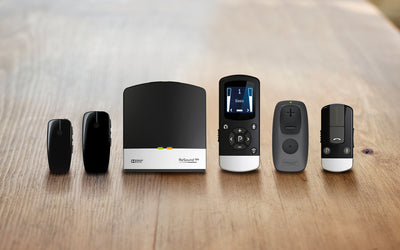By
Niamh Harnett
When it comes to hearing aids there are plenty of options to choose from. You can choose different types of hearing aids, different colours and styles, but the most important factor to consider is your level of hearing loss.
Your loss is mild, moderate or severe will have the greatest impact on which hearing aid will provide you with the best restoration of your hearing. Those who suffer with severe hearing loss may benefit more from a BTE style hearing aid.
In this blog we will discuss two popular styles of hearing aids which includes RIC (Receiver-in-the-Canal) and BTE (Behind-the-Ear) devices. These two hearing aids may look similar and can often be confused for each other yet there are multiple key differences that set them apart.
RIC vs BTE: Similarities
Both RIC and BTE hearing aids feature a hard case, sometimes called the ‘shell’ that sits behind the ear. Depending on the type of device this case is home to most, and in some cases all the hearing aids electronic components, such as the microphone, amplifier, digital chip and with BTE devices, the speaker.
Both these styles of hearing aids also consist of an earpiece that is placed in the ear. This earpiece connects to the hearing aid via tubing, an ear hook or possibly a thin wire – this element of the device will depend on the style chosen.
Regarding the technology of the devices both the RIC and BTE hearings aids are outfitted to enhance your hearing to impressive levels. Depending on the hearing aid you choose you can find the following capabilities in the latest models of RIC and BTE devices:
- Bluetooth capabilities, allowing for direct streaming from your compatible devices.
- Tinnitus relief.
- Fully rechargeable devices, removing the need to replace batteries periodically.
- Remote adjustment of settings via mobile app.

Phonak Marvel Audeo M90 (RIC) Phonak Paradise Naida P90 (BTE)
RIC vs BTE: Differences
One of the most important differences to note between RIC and BTE hearing aids is the location of the speaker (receiver). Receiver-in-the-Canal hearing aids have the speaker at the end of a thin electric wire connected to the shell of the device. The speaker is enclosed inside a flexible ear dome or mould and is placed in the ear.
Behind-the-Ear hearing aids differ from RICs in that the location of the speaker is inside the shell of the device along with the other electrical components.
The next thing to note is the size of these devices. Housing all the electronic parts of the hearing aid inside the case means that traditionally BTE hearing aids have been larger than RICs. However, it is important to note that BTE styles are slowly morphing to compete with the slimmer, sleeker design of RIC hearing aids.
The last thing to note when comparing BTE and RIC hearing aids is their amplification abilities. The larger shell and elongated body of BTE hearing aids allows them to house larger batteries and impressive amplifiers.
This provides BTE devices with the ability to substantially magnify sounds in both high and low frequency ranges. That is not to say RIC hearing aids do not offer substantial improvement and considerable range.
What is the best Behind-the-ear (BTE) hearing aid?
When choosing a hearing aid there are a number of factors to consider and you can read more about them here. However the latest BTE model to be praised by audiologists worldwide is the impressive Phonak Naida P90 as well as the powerful Signia Motion Charge & Go!
The Phonak Naida P90 is suitable for severe hearing loss and diverse listening environments, connects wirelessly to various devices and includes tinnitus support, various program options, and smartphone control app. While the Signia Motion fosters long-lasting battery life with flexible charging options, effectively separates speech from noise and Own Voice processing for natural amplification.
What is the best Receiver-in-the-Canal (RIC) hearing aid?
The Phonak Audeo Lumity L90 shines as a top RIC hearing aid, offering extensive Bluetooth connectivity, customizable features like tap control and AutoSense, and top-tier accessories. Its advanced ear moulds and unmatched waterproof rating further solidify its position as a leader in the market, though only available in rechargeable models.
If you need help choosing the right hearing aid for your level of hearing loss, or would like more information please contact us and we would be delighted to help.

Shop All Hearing Aids
Shop now
Shop Accessories
Shop now
Speak To Our Audiologists
Contact Us
